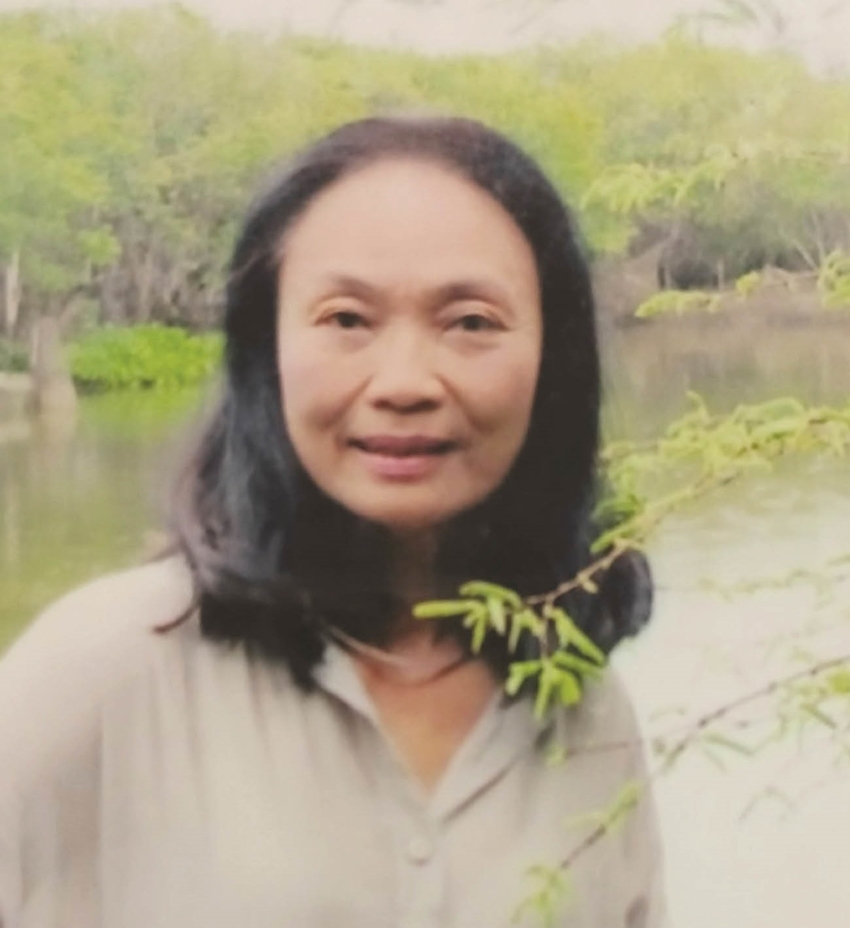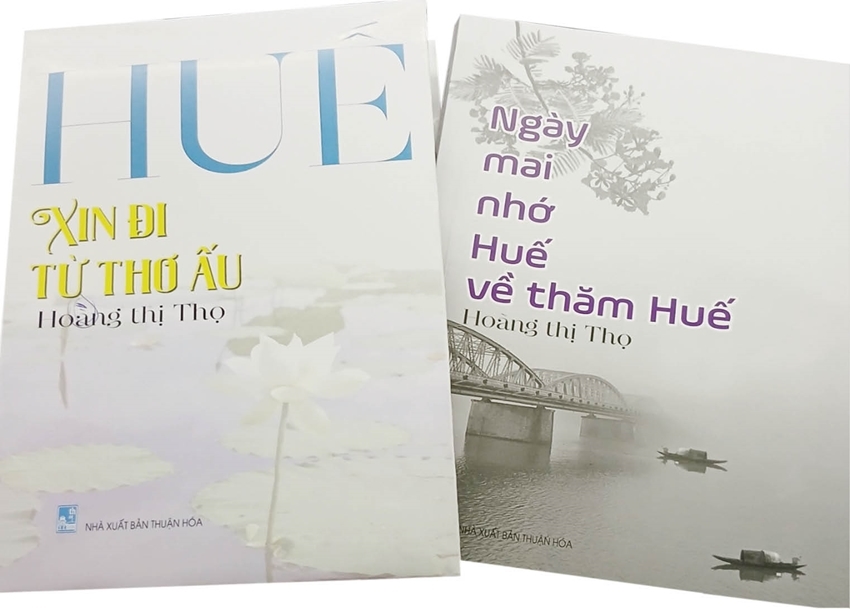 |
| Hoang Thi Tho, a journalist and former Permanent Vice President of Thua Thien Hue Journalists Association (1989-2008) |
Although it is about books, the conversation with Thua Thien Hue Weekly of Hoang Thi Tho began with journalism, a profession to which she has devoted several decades.
In January 1975, amid the fierce battlefield, she was arranged to go to Hanoi to take the university entrance exam for journalism. For that Hue girl, it was a great happiness to study the profession she loved from her years of activity in the urban movement in the South in Hue.
In 1979, after graduating, she returned to her hometown and worked at Hue Radio. After 10 years of dedication there, she took on a new role at the Provincial Journalists Association in 1989. She took on this pioneering role, fraught with challenges and lacking precedent, not out of choice but necessity. For two decades, she served as the de facto leader of the Provincial Journalists Association, holding the position of Permanent Vice President through four terms in the absence of a full-time President.
That long journey of beginning and dedication must have left you with many unforgettable memories?
In the early years of its establishment, the Association had only two people, with a temporary room at Dan newspaper of Binh Tri Thien province, and then Hue Radio. The most difficult issue was the funding for activities. We organized journalism awards where, despite completing the selection process and all preparatory work, prize distribution was delayed pending fund release from the Finance Department. We organized photojournalism exhibitions that concluded long before the Association could secure funds to compensate the contributing journalists and photographers.
 |
| Hoang Thi Tho's two books are set to launch on June 23 in Hue. |
Despite numerous challenges, the Association's primary focus was to mobilize all available resources to cultivate political courage, hone professional skills, and reinforce journalistic ethics and integrity.We pioneered university-level journalism courses for hundreds of reporters across the central provinces and established 16 journalism awards, laying the foundation for the current Hai Trieu Journalism Award.
The Association's initiatives and awards spurred journalists to produce high-quality work, elevating provincial journalism. Our innovative and dynamic programs not only fostered creativity but also heightened public recognition of the Thua Thien Hue Journalists Association's significance.
Your two decades of dedicated service to the association coincided with your prolific writing about Hue, establishing journalist Hoang Thi Tho as a household name among readers. How did you manage to balance these demanding roles?
During my tenure with the association, I seized every spare moment to cycle off and write. This wasn't just a hobby; it was essential for my effectiveness in the association's work. For those passionate about journalism, writing isn't merely a task - it's a vital expression of our professional identity. My role in the association demanded firsthand writing experience to truly grasp the intricacies of our profession. This insight was crucial in transforming the Association into a nurturing ground for journalists -cultivating their courage, honing their skills, and fueling their passion. Our goal was to foster professionals who didn't just work in journalism, but lived it fully.
While serving as the chief editor of the Hue Journalist publication since 1995, I simultaneously pursued freelance opportunities, crafting articles about Hue for various national newspapers. The collections 'Tomorrow Remember to Visit Hue' and 'Please Go from Childhood,' featuring over 50 articles, represent the distilled essence of my two-decade journalistic journey.
Given your focus on Hue, do you find writing about the city a challenging or effortless endeavor?
In the foreword to “Please Go from Childhood,” Dr. Nguyen Thi Tinh Thy notes that Hue's beauty, poetic essence, and dreamlike qualities have been extensively explored in literature, music, and art. She cautions that without a fresh approach, new works risk retreading familiar ground. Hue, however, is a treasure trove of intrinsic value, with layers of hidden depth that, when approached thoughtfully, can yield fresh insights – “pure gold nuggets” - to captivate readers. In my experience, writing about Hue is paradoxically both challenging and rewarding. It demands profound love and total immersion in every facet of the city. With wholehearted dedication, revelations inevitably surface. Yet, some articles have required me up to two years of careful crafting to reach fruition.
With 50 articles about Hue's gardens, Ao Dai, shrimp paste, birds, blue jellyfish, rivers, mountains, singers..., what do you want to convey through your two books?
Through extensive travels and attentive listening, I've come to appreciate that "Hue's beauty is unique." A city seemingly "inlaid and embedded into nature", surrounded by verdant mountains, rivers, gardens, and fields. Nowhere else have I witnessed such a symbiotic relationship between people and their environment. In Hue, the connection is so profound that one might imagine its inhabitants couldn't survive without the lush flora that envelops them. Hue embodies a paradox: grand and noble, yet simultaneously elegant and rustic. Its rusticity echoes in the late artist Dinh Cuong's poignant verse: “Ra đi mới biết lòng vô hạn/Sương có mờ đi trên sông Hương” (Only upon leaving do I realize boundless love / Is the mist still on the Perfume River). This essence permeates Hue's iconic lanterns, the timeless grace of its Ao Dai, and its cuisine - from refined delicacies to the humble fermented shrimp paste “even the king craved…” I've poured my heart into capturing Hue's full spectrum, from its rustic charm to its elegant sophistication, aiming to deepen the affection of those already captivated by the city's allure.
Beyond your immersion in the verdant world of flora, beyond your pure and translucent love for Hue, don't your writings also, here and there, swell with undercurrents of worry?
In 1979, fresh from graduating from the journalism university in Hanoi, I received an enticing offer. Journalist Le Van Nuoi, Editor-in-Chief of Tuoi Tre newspaper, eagerly invited me to join their team in Ho Chi Minh City. However, I declined, explaining that his attachment to his city mirrored my devotion to Hue. I simply couldn't bring myself to leave. My profound love for Hue, perhaps, breeds constant concern. I find myself anxious about every change, every renewal, every splash of vibrant color that might clash with Hue's essence. For Hue, at its core, is “calm”. Then there's the story of old houses gradually disappearing. The dilemma of preserving the ancient Bao Vinh - Gia Hoi - Thanh Ha commercial port and the historic Hoa Chau city while pursuing tourism development goals looms large. And what of Phuoc Tich's once-glorious pottery craft? Should it be reduced to firing a few batches during festivals, only to fall silent thereafter? My love for Hue is such that I carry its essence with me everywhere, using it as a lens through which I view the world. I constantly compare what I see and learn, always hoping that these insights will help Hue flourish and become even more beautiful.
If you have any advice for young writers, what would you share with them?
Journalism is a demanding profession, often fraught with peril. For female journalists, the challenges are even more pronounced. Today, journalism demands more than ever: not just knowledge, bravery, skill, and ethics, but also operational sensitivity and the ability to manage the relentless pressure of timeliness, quantity, and quality in news production. Never before have journalists' integrity and character been so tested, facing lethal temptations and navigating a world where the line between truth and falsehood is perilously thin. Yet, I believe that as long as there exists a genuine passion for the profession, a willingness to learn and listen, and a readiness to immerse oneself in life's realities, young writers will find their place. Their works will endure, resonating in the hearts of readers.
Thank you!
